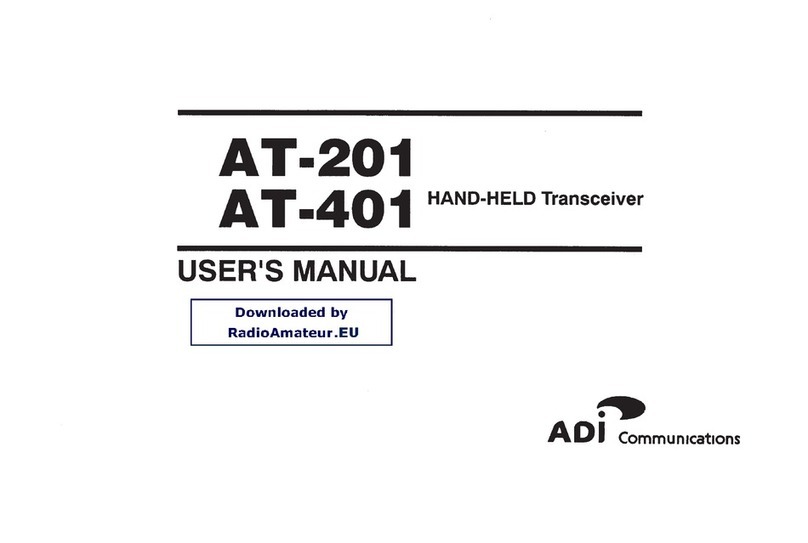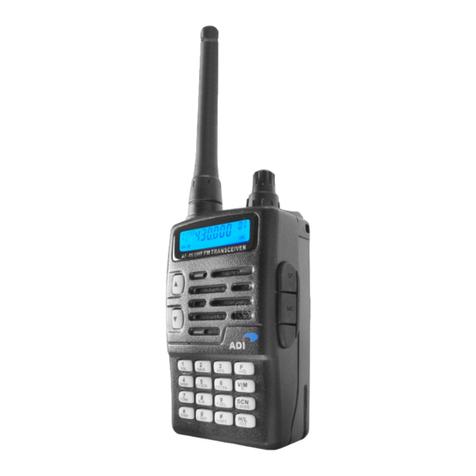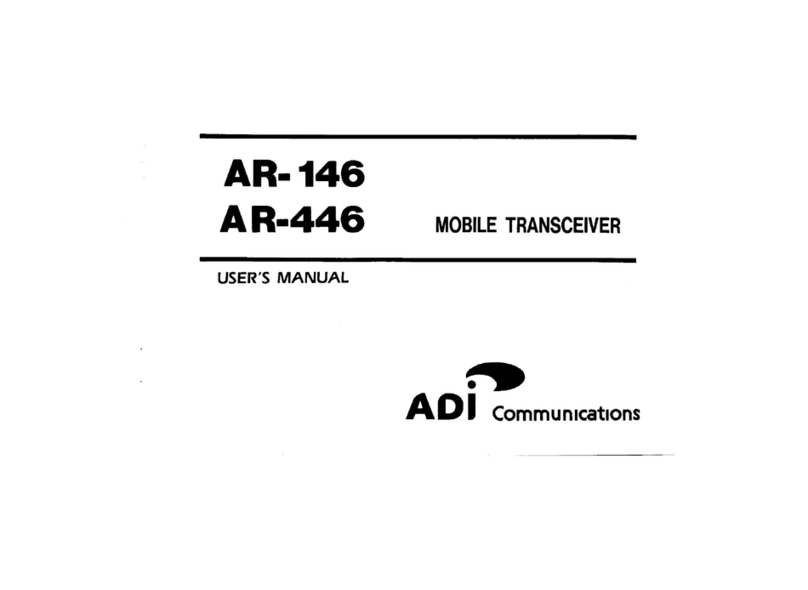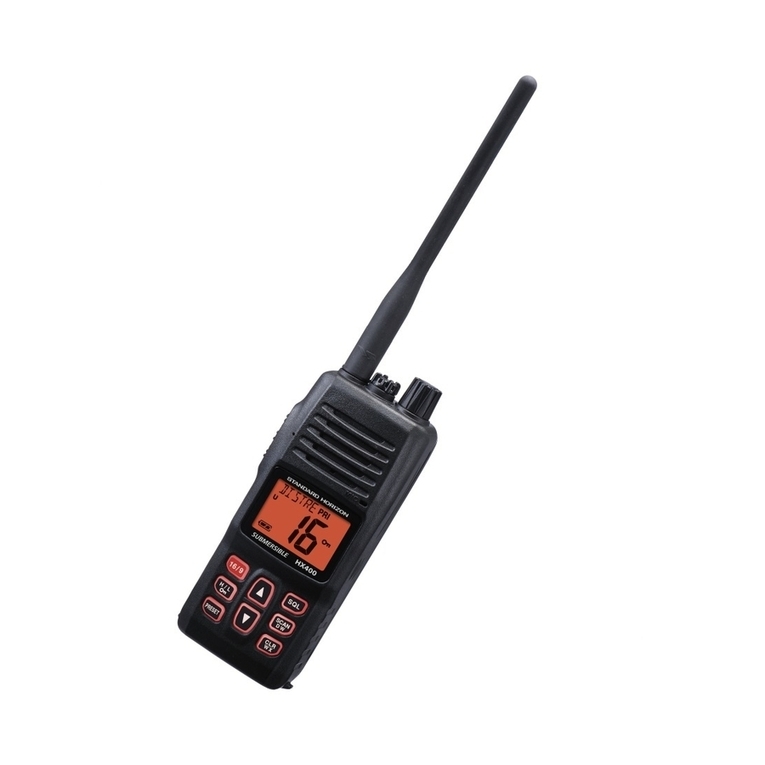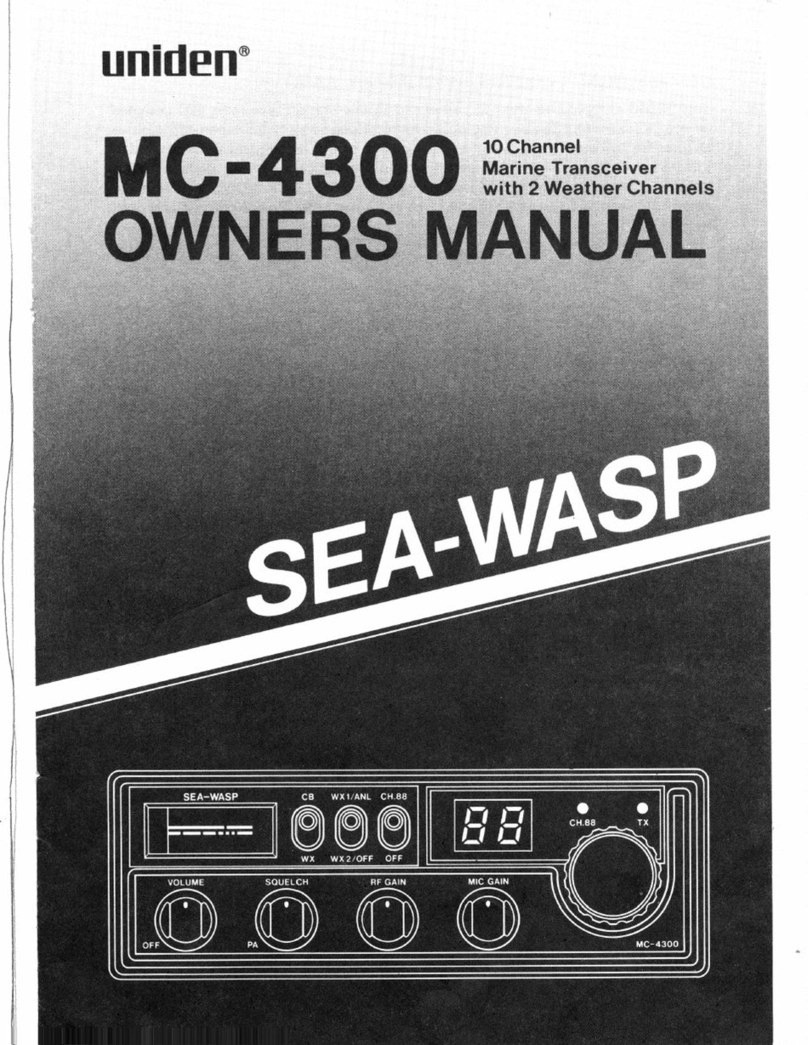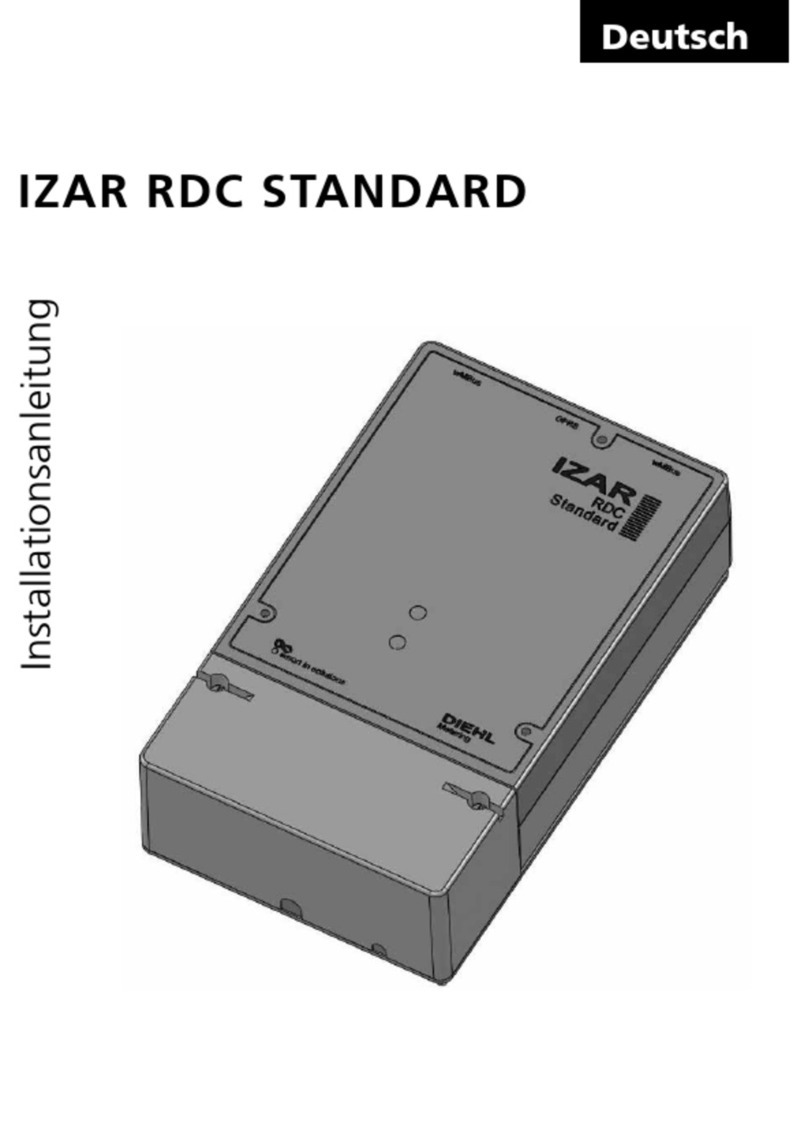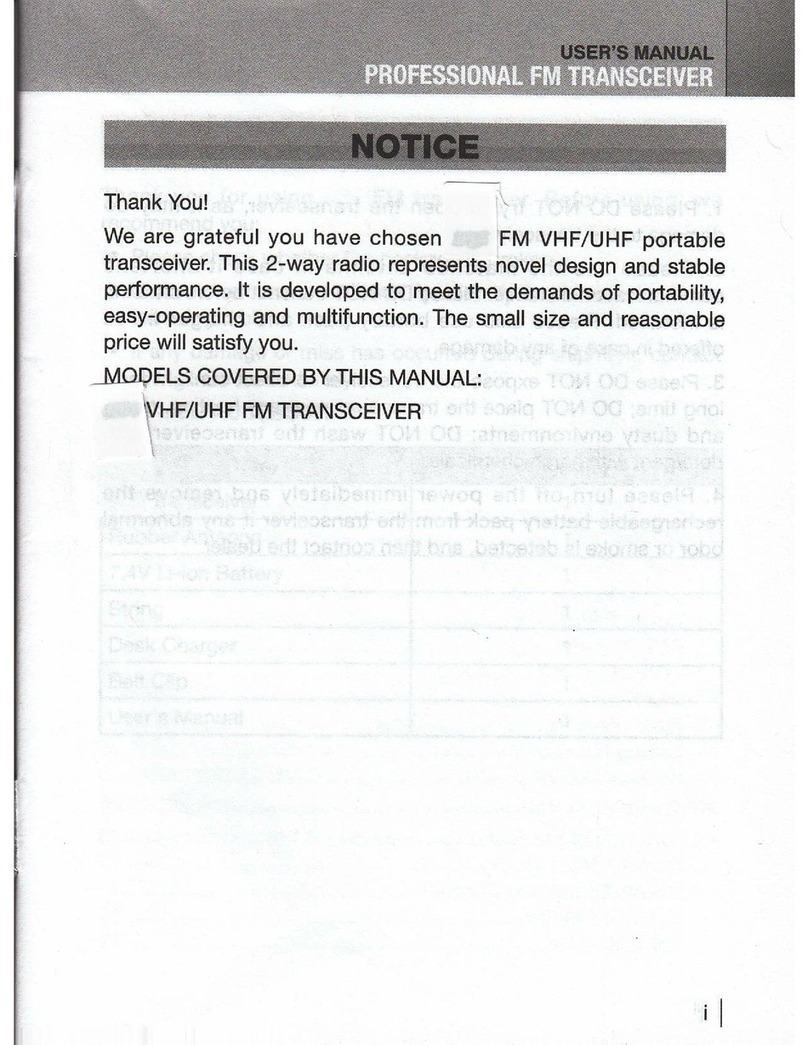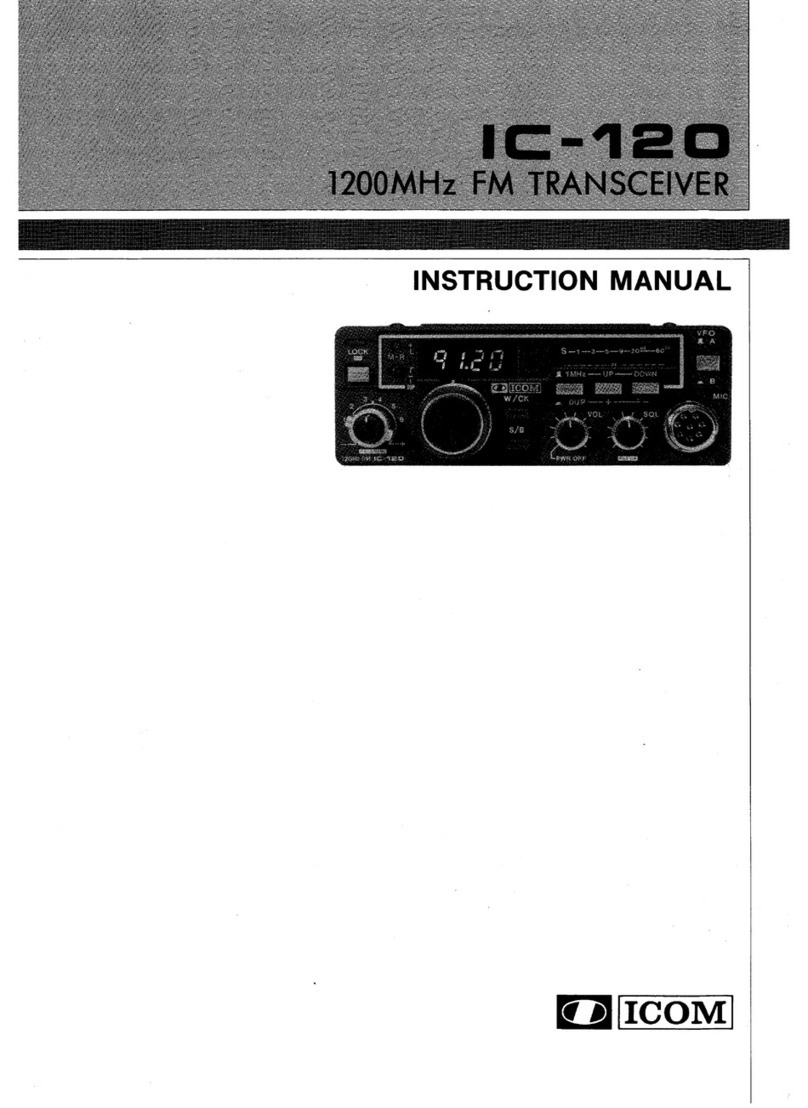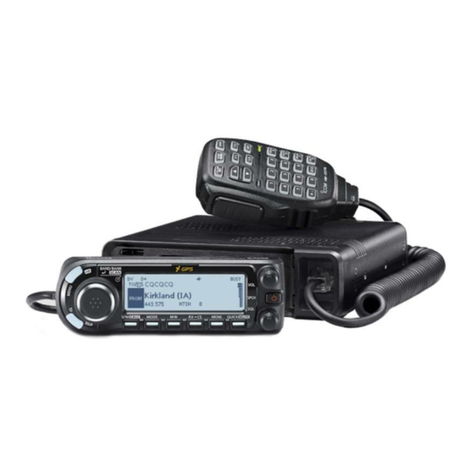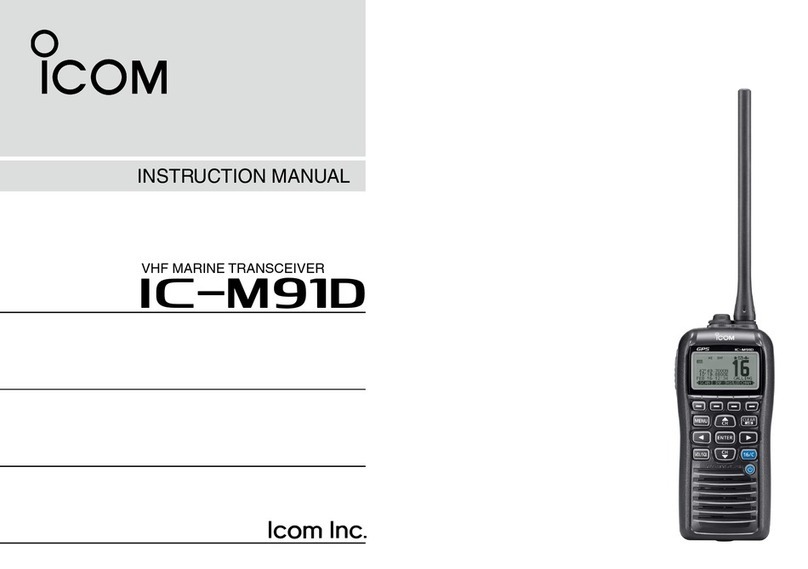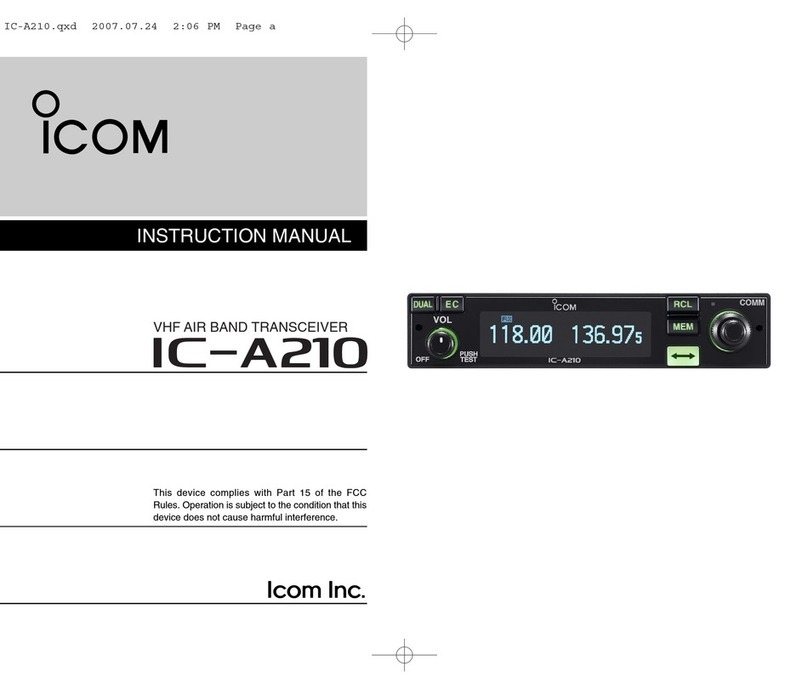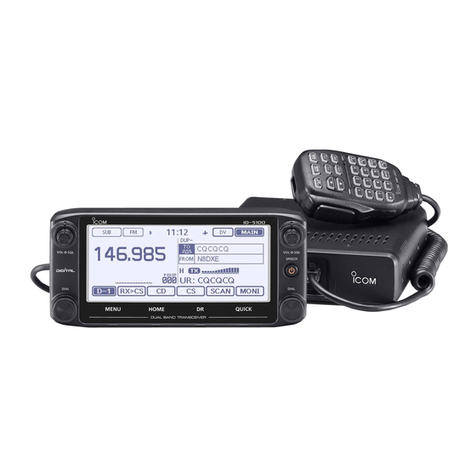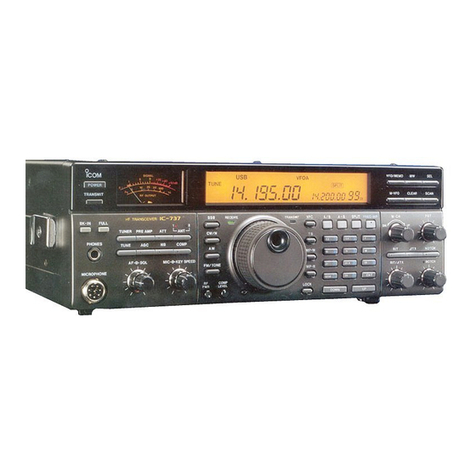ADI AR-147 User manual

AR-147
AR-247
AR-447
TMA-281A
COMMANDO 246 BM
MOBILE TRANSCEIVER
USER'S MANUAL

1
Thank you for purchasing this VHF/UHF mobile transceiver.
IMPORTANT
Please read this instruction manual carefully before attempting
operation.
If disregarded, inconvenience only, no risk of equipment damage
or personal injury.
Long transmission or extended operation in the HI power mode
might cause the rear of this transceiver to get warm.
Do not place the transceiver where the heat sink (rear panel)
might come in contact with plastic or vinyl surfaces.
SAVE THIS INSTRUCTION MANUAL.
CAUTION:
This Instruction Manual covers the following models.
AR-147 144MHz FM TRANSCEIVER
AR-247 222/230/250MHz FM TRANSCEIVER
AR-447 430/440MHz FM TRANSCEIVER
TM281A 144MHz FM TRANSCEIVER
COMMANDO 246BM 245/246 MHz TRANSCEIVER
NOTE:
Equipment damage may occur, but not personal injury.
FCC WARNING
This equipment generates or uses radio frequency energy.
Changes or modifications to this equipment may cause harmful
interference unless the modifications are expressly approved in
the instruction manual. The user could lose the authority to
operation this equipment if an unauthorized change or
modification is made.
CAUTION:

2
REPEATER OPERATION
Transmitter Offset.........................................................................24
Automatic Repeater Offset...........................................................24
Reverse Function.........................................................................24
Tone Operation............................................................................ 25
CTCSS Tone Selection................................................................ 25
DCS Code Selection....................................................................26
CTCSS/DCS FEATURE SELECTION......................................... 27
CTCSS Tone/DCS Code Scan.................................................... 27
C.SQ(Code Squelch System) OPERATION..............................27
PAGING....................................................................................... 30
DTMF CODE DECODING FUNCTION....................................... 35
DTMF AUTODIALER OPERATION.............................................36
DTMF REDIALER OPERATION..................................................37
KEYPAD DIRECT FREQUENCY ENTRY....................................37
APO(Automatic Power Off)........................................................37
DIM(Dimmer)...............................................................................37
BEEP........................................................................................... 38
LOCK...........................................................................................38
CHANNEL DISPLAY................................................................... 39
AM RECEPTION(AR-147 option only)...................................... 39
6. KEY FUNCTION LIST.................................................................. 40
7. MAINTENANCE...........................................................................42
GENERAL INFORMATION......................................................... 42
SERVICE..................................................................................... 42
IN CASE OF DIFFICULTY.......................................................... 43
1. BEFORE OPERATION................................................................ 3
2. SPECIFICATIONS....................................................................... 5
3. ACCESSORIES........................................................................... 6
4. INSTALLATION INSTRUCTION.................................................. 6
5. OPERATION................................................................................ 9
CONTROL FUNCTION............................................................... 9
RECEIVER OPERATION
Reception....................................................................................14
Frequency Selection................................................................... 15
Frequency Step Selection...........................................................15
TRANSMITTER OPERATION
Transmit Basics........................................................................... 16
Time-out Timer(TOT).................................................................. 16
MEMORY
Memory Channels.......................................................................17
Initial State.................................................................................. 17
System Memory Initialization......................................................17
Specific Memory Channels.........................................................18
Memory Entry..............................................................................18
Memory Channel Recall............................................................. 19
Memory Shift...............................................................................19
Memory Channel Clear............................................................... 19
SCAN
Scan Operation...........................................................................20
Hold/Resume Programming........................................................20
Band Scan...................................................................................20
Programmable Band Scan.......................................................... 21
Memory Channel Scan............................................................... 21
Memory Channel Lockout...........................................................22
DUAL-WATCH OPERATION...................................................... 22

3
BEFORE OPERATION
TO PREVENT ELECTRIC SHOCK, FIRE AND OTHER INJURY.
PLEASE NOTE THE FOLLOWING:
To avoid risk of electric shock , under no circumstances should the
unit be opened.
Do not place this unit, where it will be exposed to direct sunlight or
close to heating appliances.
To ensure good ventilation, do not put anything on top of the cabinet
and allow at least 15cm (6 inch) of space behind the unit.
The power requirement is 13.8 VDC.
Never attempt connection to a 24 VDC source.
Do not place the Unit in areas off excessive dust, high humidity or
on unstable surfaces.
Do not drop pieces of metal, needles, coins and other electrically
conductive materials into the unit.

4
Do not touch the power plug when your hands are wet. CLEANING
1. Turn the power off, before cleaning the unit.
2. Do not use any type of abrasive pad, thinner , benzine or any
substances which may damage the unit.
3. Wipe the front panel and other exterior surfaces of the with a soft
dry cloth or a soft cloth lightly moistened with water.
If an abnormal odor or smoke is detected, immediately turn the
power off and pull out the power plug. Connect the ADI service
station or our dealer.
Do not pull the power cord, when disconnecting it from the AC wall
outlet. Grasp the plug and ensure that your fingers do not touch the
live pins.

5
Frequency range (MHz)
Mode
Antenna impedance
Operating temperature
Power requirements
Ground
Current drain
Frequency Stability
Dimensions (WxHxD) (mm)(Projections included)
Weight (kg)
Output power
Modulation
Spurious radiation
Maximum frequency deviation
Audio distortion(at 60% modulation)
Microphone impedance
Circuitry
Intermediate frequency 1st / 2nd
Sensitivity (12dB SINAD)
Selectivity
Squelch sensitivity
Audio output(10% distortion)
External speaker impedance
Note:1.Circuit and ratings are subject to change without prior notice due to advancement in technology.
2.Recommended duty cycle: 1 minute:Transmit, 3minutes Reception.
Transmit mode
Receive mode
HI
MID
LOW
AR-247AR-147 AR-447
250 to 270
230 to 250
222 to 225(USA)
144 to146
144 to148(USA) 430 to 440
TM281A
144 to148(THA)
COMMANDO 246BM
245 to 246(THA)
F3E(FM)
50Ω
-20˚C to +60˚C (-4˚F to +140˚F)
13.8V DC ±15%(11.7~15.8V)
Negative
Less than 9ALess than 12A
Less than 0.6A
Less than10A Less than12A Less than9A
Less than ±5ppm
140x40x166(5-1/2" x 1-37/64" x 6-17/32")
1.2(2.65lbs)
Approx 60W
Approx 25W
Approx 7W
Approx 30W
Approx 15W
Approx 7W
Approx 35W
Approx 15W
Approx 7W
Approx 60W
Approx 25W
Approx 7W
Approx 30W
Approx 15W
Approx 7W
Reactance modulation
Less than -80dB Less than -70dB Less than -65dB Less than -80dB Less than -70dB
±5kHz
Less than 3%(300 to 3000 Hz)
2.2kΩ
Dual conversion superheterodyne
10.7MHz/455kHz 30.85MHz/455kHz 30.85MHz/455kHz 10.7MHz/455kHz 30.85MHz/455kHz
Less than 0.18 uV
70 dB 70 dB 65 dB 70 dB 70 dB
Less than 0.1 uV Less than 0.177 uV Less than 0.177 uV Less than 0.177 uV Less than 0.177 uV
More than 2W across 8Ωload
8Ω
2. SPECIFICATIONS
General
Transmitter
Receiver

6
ACCESSORIES
Unpack your new transceiver carefully, and examine it for visible
damage If the equipment has been damaged in shipment, notify the
transportation company immediately. Save the boxes and packing
material for future shipping.
The following accessories should be included in the box with the
transceiver.
DTMF Microphone
MC147D.......................................................................................1 ea.
or
Dynamic Microphone
(GENERAL market only) MC147..................................................1 ea.
Stacking plate
DC power Cable...........................................................................1 ea.
Fuse..............................................................................................1 ea.
Instruction Manual........................................................................1 ea.
Warranty Card.............................................................................. 1 ea.
INSTALLATION INSTRUCTION
4.1 INSTRUCTION
MOUNTING BRACKET
When installing the transceiver in a vehicle consider the ease of
operation and safety when selecting the location for the mounting
bracket.
1. Install the bracket using the supplied flat washer and self tapping
screws (4 pc s. each).
2. Attach the transceiver loosely using the 4 SEMs screws.
3. Align the grooves in the bracket with the transceiver's screws
(Fig. A ) and slide the transceiver to the rear.
4. Adjust the viewing angle in the bracket to the desired position
(Fig. B).
5. Hold the transceiver in place and tighten the 4 SEMS screws
using the supplied wrench.

7
4-2 CONNECTOR
4-2-1 Mobile Installations
Cautions:
1. Before installing the power cable, be sure to remove the
negative lead from the battery for safety.
2. After installation and wiring, be sure to double check for
correct installation before reconnecting the negative lead
to thebattery terminal.
3. If the fuse opens, be sure to check the each conductor has
been damaged by short circuiting, etc. Then replace with a
new fuse of the same rating.
4. After completing the wiring , wrap the fuse holder with heat
resistant tape to protect against heat and moisture.
5. Do not remove the fuse even if the power cable is too long.
A. Battery Connections
Connect the power cable directly to the battery terminals. Using of
the cigarette lighter socket will lead to a poor connection, and will
result in poor performance. Pay close attention to the polarity of the
cables when connecting them to the battery.
B. Ignition Noise
This transceiver has been designed to suppress ignition noise;
however, if excessive noise is present, it may be necessary to use
suppressor spark plugs (with resistors).

8
4-2-2 Fixed Station
4-2-3 Antenna
A regulated DC power supply (13.8 VDC capable of supplying at less
11 Amperes) is required.
The type of antenna that is use will greatly affect the performance of
the transceiver. Use a properly adjusted antenna, of good quality, to
enable your transceiver to perform at its best. The antenna input
impedance is 50 ohms. Use 50-ohm coxial cable such as RG-8U or
8D-2V for this connection. If the antenna is far from the transceiver
the use of low coaxial cable, such as RG-8U is recommended.
Match the impedance of the coaxial cable and that of the antenna so
that the SWR is less than 1.5 to 10. The protection circuit in the
transceiver will activate if the SWR is particularity poor (greater than
3 to 1).
High SWR values will cause the transceiver output to drop, and may
lead to TVI or BCI reports.
1. Never connect the AC power cable to the AC until all other
connections have been made.
2. Before connecting and disconnecting the power connector, be
sure to turn OFF the POWER switches of both the transceiver
and the DC power supply.
3. Observe polarity of the DC power cable. The Transceiver
operates on 13.8 VDC, negative ground. Battery polarity must
be correct. The power cable is color coded:
Red + (Positive polarity)
Red - (Negative polarity)
4. The transceiver has voltage protection which keeps the voltage
under 18VDC.
5. Once the voltage is over 18VDC, the transceiver will shut
down automatically. To restart the system, adjust the voltage
to 13.8VDC and switch off the power then switch on again.
We recommend that you install a high quality lightening arrestor
in your antenna lines for protection again fire, electric shock,
personal injury, or damage to the radio itself.
CAUTION:

9
5 OPERATION
5-1-1 CONTROL FUNCTIONS
POWER switch
Press to turn the transceiver on or off.
Press the VFO/MV or MR/M key and switching the power on will
reset the VFO or MEMORY.
Tuning control
This control is used to select the desired transmit/receive
frequency, MHz step, memory channel, frequency step, tone
frequency, scan direction, etc.
VOL control
This control is used to adjust the volume from the internal and
external speaker (if used). Clockwise rotation will increase the
volume and counterclockwise rotation will decrease the volume.
SQ(Squelch) control
This control is used to select the desired squelch threshold level.
LOW/DIM key
LOW
This function is used to select the transmit output power level (HI,
MID or LOW)
DIM
This function is used to select the intensity of the front panel
display illumination.
Pressing the F key for longer than 1 second and then press the
LOW/DIM key while the F indicator is flashing will turn the time-out
timer function on and off.
Microphone connector
Attach the supplied microphone to this connector. The pin out of
the connector is shown in the accompanying illustration.

10
VFO/MV key
This key is used to VFO operation after operating in the MR or
CALL channel mode. Pressing this key will allow the turning
control and microphone UP/DN keys to increase or decrease the
operating frequency.
Press and hold the key for longer than 1 second to initiate VFO
scan. Pressing the key after scan has been initiated will cause
scan to stop.
Pressing the key within 10 seconds of pressing the F key will copy
the memory channel or call channel data to the VFO. This allows
you to change parameters of the channel without actually
changing the data that has been stored in memory.
Pressing the key F key for longer than 1 second and then pressing
the VFO key will allow you to set the offset frequency.
If you press and hold the VFO key while you turn on the POWER
switch you will reset the microphone's VFO memory, without
destroying the memory channel or call channel data. (VFO Reset)
MR/M key
This key is used to select MR (Memory Recall) mode from the VFO
mode. The Tuning control can then be used to select the desired
memory channel.
Press the key for longer than 1 second will initiate memory
channel scanning.
Pressing the key within 10 second of pressing the F key will store
the display data into memory.
In the MR channel mode pressing the F key for longer than 1
second and then pressing the MR key will cause the Memory
channel to skip during Memory channel scan mode.
If you hold and press this key while you turn on the PWR
switch you will clear all the microprocessor's operator
programmed
memory section.(system reset)
MHz/LOCK key
This key is used to tell the microprocessor that you wish to turning
the operating frequency in 1 MHz step.If the DTMF board is
installed, you also could enter the frequency with the 16-tone DTMF
keypad directly.
Pressing this key within 10 seconds of pressing the F key will
cause the key lock function to activate, protecting the currently
display data from accidental erasure.
Pressing the F key for longer than 1 second and then pressing
MHz/LOCK key while the indicator is flashing will turn the
AUTOMATIC POWER OFF function on or off.

11
and scan step size. Use the tuning control to select the desired
tuning step and then press any front panel key except the PWR
switch to return to the normal frequency display.
TONE/DUAL key
TONE (CTCSS/DCS) function
Pressing this key by itself causes the radio to select the desired
subaudible tone signaling mode. When the "T." indicator is
illuminated in the display the transceiver will transmit the the
selected CTCSS tone. When the "T.SQ" indicator is illuminated the
transceiver will both transmit the subaudible tone and will also
remain squelched until the selected CTCSS tone is received.
When the "DCS" and "T." indicators illuminated, the Transceiver will
transmit the selected DCS code. If the "SQ" indicator also
illuminated, the transceiver will remain squelched until the selected
DCS code is received.
TONE (CTCSS/DCS) selection
Pressing the F key for longer than 1 second and then pressing the
TONE/DUAL key will allow you to select the desired subaudible
tone . To change to a different subaudible tone rotate the turning
control or press the UP/DN switches on the microphone until the
desired subaudible tone appears in the display. To return to the
normal frequency display you can press any front panel key
except the PWR switch.
DUAL function
If you press the F key momentarily and then press the
TONE/DUAL key, DUAL function will be activated.
This function allows you to watch two different frequencies. The
Transceiver is capable of following types of dual-watch
operation.
(1)
Listen on the dial-frequency and the memory frequency under M1.
(2)
Listen on the dial-frequency and one of the memory frequencies.
(3)
Listen on the dial-frequency and a memory frequency under
scanning.
CALL key
Press this key to activate the call channel function. Press the F
key momentarily and then press the CALL key to store the
currently displayed data into the CALL channel(except that
PAG/C.SQ activated in VFO mode).The radio will allow you up to 10
seconds to press the CALL key after pressing the F key.
Pressing the F key form longer than 1 second and then pressing
the CAll key will enable/disable the programming scan mode.
Press the key within 10 seconds of pressing the F key while
PAG/CSQ is active will allow you to change the DTMF transmitting
delay time.
SHFT/REV key
SHIFT function
Pressing this key alone to select the desired transmitter offset
feature. Pressing the key will cause the radio to shift from one
offset feature to the next, i.e. "-"(minus offset) to "+"(plus offset)
to"- +"(automatic repeater mode), then back to simplex mode
where no indicator shows.
REV function
Pressing the key within 10 seconds of pressing of pressing the F
key will reverse the transmit/receive frequencies during repeater
operation.
If you have selected simplex this key will not function!
Pressing the F key for longer than 1 second and then the
SHFT/REV key will allow you to select the desired VFO tuning step

12
DTMF key
Pressing this key alone to select the PAG, CSQ function if the
DTMF board is installed. Otherwise, a BU-sound will be
generated. Pressing the F key for longer than 1 second and
pressing the DTMF key will turn the BEEP function OFF or ON.
5-1-2 LCD Display Panel
TOT On when the Time Out Timer function has been activated.
SCAN On when the VFO/MR SCAN function has been
activated.
B On when the Busy SCAN flag is active.
PAG On when the DTMF PAGING function is active.
C.SQ On when the code squelch function has been activated.
DCS On when DCS(Digital Code Squelch) function has been
activated.
HML Indicates the relative output power setting for transmit.
BUSY On when the squelch opens.
This level meter indicates the relative receiver signal
strength or the relative transceiver power output.
TX On during transmit.
F On whenever the function has been depressed. Also
shows the last memory channel number that has been
selected.
LOCK On when the Lock function has been activated.
Indicates the active memory channel number. SKP
indicates that the channel is lock out.
T.SQ On when the CTCSS/DCS Decode and Encode function
has been activated.
On when the CTCSS/DCS Encode function has been
activated.
REV On when the Reserve function has been activated.
- + Display the selected transmitter Offset direction.
Both - and + light when during Automatic Repeater
function is activated.
APO On when the Automatic Power Off function has been
activated.
Displays the operating frequency to the nearest kHz digit;
or the tone frequency etc.
On when DTMF Autodialer function has been
activated.
DUAL On when DUAL-watch function is active.

13
5-1-3 Rear Panel 5-1-4 Microphone
ANTENNA connector
Attach an antenna with a low SWR and impedance of 50 ohms.
13.8 VDC power input connector
Connect the supplied DC power cable to this connector.
Pay close attention to the polarity. Red is positive and black is
negative.
Fuse holder
Contains a required fuse.
Do not use a larger fuse as damage might result to the transceiver.
External speaker jack
This jack is used to connect an external speaker. The speaker
should have an impedance of 8 ohms.
UP/DOWN switches
These switches can be used to increase or decrease the VFO
frequency, the Memory channel number, and the subaudible
tone etc..
PTT(push to Talk) switch
The transceiver will transmit whenever this switch is depressed.
CALL Key
This key functions just like the CALL key on the front of the radio.
Repeater Access Tone
The transceiver will transmit with repeater access tone whenever
this switch is depressed in Tx mode.
The repeater access tone could be selected as 1450, 1750, or
2100Hz.

14
VFO key
This key functions just like the VFO key on the front of the radio.
MR key
This key functions just like the MR key on the front of the radio.
MHz key
This key functions just like the MHz key on the front of the radio.
16-Tone DTMF keypad
These buttons are used to activate the DTMF encoder.
LOCK key
This key will deactivate all functions of the microphone except the
PTT function and DTMF key pad.
5-2 RECEIVER OPERATION
Audio confirmation is provided whenever a front panel key is
depressed. You can disable this function by pressing the F key for
longer than 1 second and then pressing the DTMF key.
5-2-1 Reception
1. Connect the power supply, antenna, and microphone and then
adjust the controls as follows:
Power switch..................OFF
Volume Control..............Full Counterclockwise
Power switch of power supply
(Fixed station)................OFF
SQ Control.....................Full Counterclockwise
2. Turn on the Power Supply and then turn on the transceivers
PWR switch. The display should indicate a frequency. Fig.1
shows examples of frequencies that will appear on the various
models. In addition to the frequency you may see one or more
control indicators illuminate on the display.
AR-147 AR-247
TM281A Commando 246BM
AR-447

15
Note
The frequencies shown above are the default frequencies after a
microprocessor reset. If the display shows incomplete data or
you think the displayed frequency is in error you should reset the
Microprocessor.
Caution
Turn off the transceiver PWR switch before you start or stop your
vehicles engine, or your home power supply.
3. Rotate the VOL control clockwise until a signal or noise is heard
coming from the speaker.
4.Rotate the tuning control or press the microphone UP/DN
switches to select an open channel. Then rotate the SQ control
clockwise until the noise just disappears and the BUSY indicator
turns off. This point is known as the Squelch Threshold point. The
squelch control must be adjusted to this setting for the Scan
functions to operate properly.
5. Select the desired operating frequency using the microphone or
tuning control. When a signal is received the S-meter will deflect
and the BUSY indicator will turn ON.
5-2-3 Frequency Step Selection
The frequency step is indicated in the chart below.
●VFO Mode Operation Frequency Selection
1. Press the VFO/MV key to select the VFO mode.
2. Rotate the tuning control or press the microphone UP/DN
switches to select the desired frequency.
●Memory Channel Selection
1. Press the MR/M key.
2. Rotate the tuning control or press the microphone UP/DN
switches to select the desired memory channel.
●CALL Channel Selection
Press the CALL key to select the Call channel.
To select the desired tuning or scan step size use the following
procedure:
5-2-2 Frequency Selection
You can change the dial frequency while in the VFO mode. The
frequency can then also be stored in memory, or in the call channel
using the techniques that will be described in this manual.
1. Press the VFO/MV key to select the VFO mode.
2. Press the F key for longer than 1 second. The F indicator should
light in the display.
3. Press the SHFT/REV key within 10 seconds of pressing the F key.
The current frequency step size will be displayed.
→
→
Frequency step
(KHz) 510 →
→
12.5 →
→
15 →
→
20 →
→
25 →
→
50

16
4. Rotate the tuning control or press the UP/DN switches on the
microphone until the desired tuning step size appears in the
display.
5. To complete the programming of the step size you can press any
key on the front panel except the PWR key, or simply wait 10
seconds and the microphone will automatically return to the normal
frequency display.
5-3 TRANSMITTER OPERATION
Caution
1. Ensure that an antenna with a low standing wave ration (SWR)
is attached to the antenna connector before attempting to
transmit failure to provide proper termination may result in
damage to the final amplifier section.
2. Always check to ensure the frequency is clear before
transmitting.
Note
The use LOW power is recommended whenever possible, to
avoid interference with other stations.
5-3-1 Transmit Basics
1. Select the desired operation frequency using any of the methods
previously discussed.
2. Press the LOW/DIM key to select the desired transmit output.
3. Check the frequency to see if it is occupied before you transmit.
4. Press the PTT switch. The TX indicator will light, and the RF
meter will deflect to the right.
If you have selected the LOW power position, the indicator will
appear in the display and the RF meter will only deflect full scale.
5. Speak into the microphone. The recommended distance to the
microphone is 5 cm (2 inches).
A "OFF" will appear on the display if TX frequency is out of the
range.
5-3-2 Time-out-Timer(TOT)
The TOT can limit the continuous transmission time to the TOT
time(the default time is 10 minutes).
1. Press the F key for longer than 1 second,then press the LOW/DIM
key. The TOT indicator will light.Rotate the tuning control or press
the UP/DN switches on the microphone to select the TOT
time(1/3/5/10/15/30 minutes).
To cancel the TOT setting, repeat the same procedure.
2. When the time of time-out timer is out, the transceiver will disable
the transmitter. To transmit again, release the PTT switch and
press it again.

17
This transceiver contains a EEPROM to retain 81 memory
channels(CALL channel included).
The data listed below can be stored in each memory channel.
5-4 MEMORY
5-4-1 Memory Channels
5-4-2 Initial State
Initial state of the transceiver from the factory is shown in the chart
below.
1. RX frequency
2. TX offset frequency
3. TX offset direction
4. Repeater access tone
5. CTCSS tone frequency
6. DCS code/polarity
7. C.SQ code
8. CTCSS/DCS status
9. PAG/C.SQ status
10. Automatic repeater mode status
11. DTMF TX speed
12. DTMF TX delay time
5-4-3 System Memory Initialization
●Memory channel Initialization (System Reset)
When you want to erase all programmed data or if the display
shows erroneous information, you should initialize (reset) the
transceiver using the following procedure.
1. Turn the PWR switch off.
2. Press and hold the MR/M key and turn on the PWR switch.
3. Release the MR/M key.
● VFO Initialization(VFO Reset)
All the settings, except the contents of the memory and call
channel, are initialized.
1. Turn the PWR switch off.
2. Press and Hold the VFO/MV key then turn
the PWR switch on.
3. Release the VFO/MV key .
AR-147 AR-247
VFO/Memory
channel 1/ CALL 144.000 223.500 440.000
channel frequency MHz MHz MHz
VFO step 10kHz 10kHz 10kHz
Memory channel 1 CH 1 CH 1 CH
CTCSS frequency 88.5Hz 88.5Hz 88.5Hz
DCS code 263 263 263
DCS Polarity Tx/Rx Normal Tx/Rx Normal Tx/Rx Normal
Repeater Access Tone
1750 Hz 1750 Hz 1750Hz
Offset Frequency 600KHz 1.6MHz 5MHz
DTMF speed 50ms 50ms 50ms
DTMF Tx delay 450 ms 450 ms 450ms
AR-447
144.000
MHz
10kHz
1 CH
88.5Hz
263
Tx/Rx Normal
1750Hz
600KHz
50ms
450ms
TM281A
245.000
MHz
10kHz
1 CH
88.5Hz
263
Tx/Rx Normal
1750Hz
1.6MHz
50ms
450ms
COMMANDO 246BM

18
5-4-4 Specific Memory Channels
This transceiver provides 81 Memory Channels(CALL channel
included).
In addition to serving as a normal Memory Channel, some of the
Memory Channels serve a dual purpose to specify other parameters.
The functions of those Memory Channels are described below.
●Memory Channel 1 is used to store the frequency for the DUAL-
WATCH function.
●Memory Channel 11 is used to store the lower limit for the
Programmable Band Scan function.
●Memory Channel 12 is used to store the upper limit for the
Programmable Band Scan function.
5-4-5 Memory Entry
●Simplex/Normal shift
1. Press the VFO/MV key to select the VFO mode.
2. Select the desired operating frequency, offset, tone, frequency,
etc.(For example 145.500MHz)
3. Press the F key. The F indicator and a memory channel indicator
will light.(For example CH8)
4. Select the desired Memory Channel using the Tuning Control or
microphone UP/DN switches.(For example CH5)
5. Press the MR/M key within 10 seconds of selecting the Memory
Channel. A beep will sound and the F indicator and the
Memory Channel number will turn on and the transceiver will
change into Memory mode.

19
●CALL Channel
1. Select the desired operating frequency in VFO mode or the
desired memory channel in memory channel mode, and be sure
that PAG/C.SQ not activated.
2. Select the desired offset frequency, tone frequency, etc.
(For example 145.500 MHz in VFO mode)
3. Press the F key. The F indicator and the memory channel
indicator will light.(For example CH8)
4. Press the CALL key within 10 seconds of pressing the F key. The
F indicator and the Memory Channel number will turn OFF, to
confirm data entry.
5-4-6 Memory Channel Recall
1. Press the MR/M key.
2. Rotate the tuning control or press the microphone UP/DN switches
to select the desired memory channel.
5-4-7 Memory Shift
This feature copies Memory channel or CALL channel data to the VFO.
This will allow you to recall and alter these frequencies without changing
the actual contents of the memory or CALL channel.
1. Press the MR/M key or CALL key.
2. Press the F key. The F indicator will light.
3. Press the VFO /MV key within 10 seconds of pressing the F key.
The F indicator and the Memory or CALL channel indicator will turn
off to signal the data has been successfully transferred to the VFO.
5-4-8 Memory Channel Clear
1. Enter the memory channel recall mode and select the desired
memory channel.
2. Press the Power Switch to turn off the transceiver.
3. Press and hold the MHz key and turn on the transceiver. Release the
MHz key, the confirmation message will appear on the display.
4. Press MR/M key in 5 seconds, the contents of the selected memory
channel are erased.
Note CALL channel entry operates only when PAG/C.SQ feature
disabled.
Other manuals for AR-147
1
This manual suits for next models
4
Table of contents
Other ADI Transceiver manuals
